Thai people love food. You can always find freshly made food 24 hours a day from a variety of eateries on every block. Here is an overview of the variety of food sources that you will find in Thailand.
Food Carts
Push Carts: In Thailand, food carts, 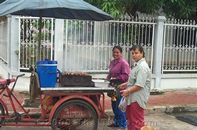 like restaurants, have loyal customers. Because these street-side-cooks
make the same 1-4 dishes every day, they are experts at that meal,
sometimes jealously guard their technique and can make incredible food.
Some of these carts stay permanently in one place, some move around from
street to street. Many carts are pushed around the residential areas with
the owner yelling or banging a distinct bell, horn or bamboo clapper to
announce the food.
like restaurants, have loyal customers. Because these street-side-cooks
make the same 1-4 dishes every day, they are experts at that meal,
sometimes jealously guard their technique and can make incredible food.
Some of these carts stay permanently in one place, some move around from
street to street. Many carts are pushed around the residential areas with
the owner yelling or banging a distinct bell, horn or bamboo clapper to
announce the food.
When I was growing up, the noodle cart on our street would come by with
this sound of the bamboo sticks tapping. I knew, if I wanted noodles, I
had better be ready at the door and yell when he came by. Where my sister
lives now, there's an icecream cart that comes by and plays a song on
their radio that causes the all the dogs in the neighborhood to howl.
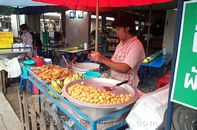 If
you were in Thailand five to ten years ago, you would see more food carts
or kiosks filling the streets of Bangkok. With the traffic jams and
sidewalks clogged up by these vendors and their customers, the government
limited the push carts to certain areas on certain days. However, as long
as there is demand, the carts will survive. Now it is sometimes a cat and
mouse game with the police.
If
you were in Thailand five to ten years ago, you would see more food carts
or kiosks filling the streets of Bangkok. With the traffic jams and
sidewalks clogged up by these vendors and their customers, the government
limited the push carts to certain areas on certain days. However, as long
as there is demand, the carts will survive. Now it is sometimes a cat and
mouse game with the police.
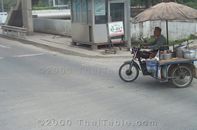 In the back of the motorcycle, there is a stove with food on top. These
motorcycles can go just about anywhere. There is one on my sisterís street
offering dry noodles with topping (goi tiew lohd). You can get a small
bag that probably fills up your dessert plate for 20 baht (1999: about $0.50)
In the back of the motorcycle, there is a stove with food on top. These
motorcycles can go just about anywhere. There is one on my sisterís street
offering dry noodles with topping (goi tiew lohd). You can get a small
bag that probably fills up your dessert plate for 20 baht (1999: about $0.50)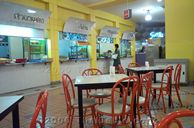 In most shopping malls, there is a food court, similar to the US malls, but 20
times as many choices. Having been pushed off the streets by the government,
many carts have gone to the malls. In most malls, customers buy coupons at a
counter and use the coupons to exchange for food.
In most shopping malls, there is a food court, similar to the US malls, but 20
times as many choices. Having been pushed off the streets by the government,
many carts have gone to the malls. In most malls, customers buy coupons at a
counter and use the coupons to exchange for food.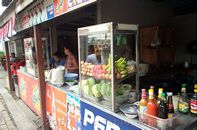 This is
where the working Thai men and women go for lunch. These places are usually jam
packed during lunch hour. It is usually right on the street with a 10 x 12 room,
with small tables. You get a bowl of noodles (goi tiew or ba
mee moo dang) for about 25 baht ($0.60).
This is
where the working Thai men and women go for lunch. These places are usually jam
packed during lunch hour. It is usually right on the street with a 10 x 12 room,
with small tables. You get a bowl of noodles (goi tiew or ba
mee moo dang) for about 25 baht ($0.60).